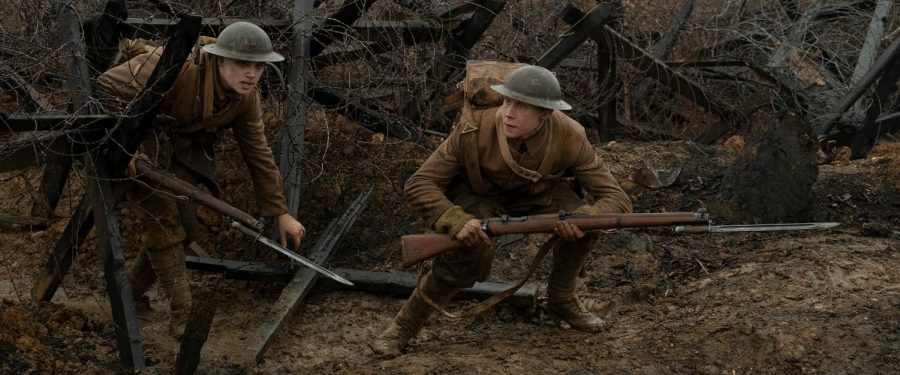1917 Immerses Audience in Brutal Trench Warfare
In 1917, Two Lance Corporals, William Schofield (George MacKay) and Tom Blake (Dean-Charles Chapman), must journey across the European countryside to deliver an urgent message by morning.
Most war movies are set in Vietnam, WWII, or the contemporary Middle East. WWI is often ignored.
It’s not that it wasn’t an interesting time, as it certainly was. It was the first industrialized war, completely changing the way wars are fought and the way wars are viewed. Unfortunately, filmmakers assume that watching a soldier cowering in a trench or running wildly to his death in no-man’s-land is not very exciting compared to the more frenetic nature of other wars.
Sean Mendes’ 1917 is a recent film set in the first World War. I don’t think you could really call it a war movie, though. It feels more like an adventure film in a WWI setting. I do not wish to discredit the film, however, as I feel it is a magnificent work of art.
The story of the film is simple. Two Lance Corporals, William Schofield (George MacKay) and Tom Blake (Dean-Charles Chapman), must journey across the European countryside to deliver an urgent message by morning. The recipient is Colonel Mackenzie (Benedict Cumberbatch) who is about to launch an attack on a seemingly retreating German force, when it is actually a trap. With communication lines cut, it’s up to this pair of soldiers to save two battalions from marching into certain demise.
The main characters do not change much in this film, if at all. While this is perhaps a missed opportunity, it is important to remember a couple things. One, the film takes place within twenty-four hours, a time frame in which any major character development may be difficult to believe. Two, the film’s main strength is in its immersive qualities.
The main gimmick of 1917 is that it has no cuts. While the picture was filmed in multiple sessions, it is edited to appear as if it was done all in one take. Therefore the viewer is never taken out of the events on screen. There are no montages, nor is there a cut to the villain to establish a later instance of dramatic irony.
One might think this may hamper the cinematography, but it doesn’t. The camera seamlessly transitions to all kinds of shots, and uses its perspective to hide things momentarily for the purposes of dramatic twists. It gives the film a sense of connectedness and fluidity that I have not seen before.
Furthermore, the film’s set design, costume design and performances are meticulously detailed based on historical records and accounts. These range from the mud and blood of no-man’s land, the endless green fields of Europe, a crumbling french village, and compact sprawling trenches. Costume design is, to my knowledge, on point and at the very least, convincing.
The actors, I feel, did an excellent job. Lines are well-written and delivered effectively. For example: In one scene, a soldier was injured in the abdomen. The way he responded to the injury, particularly when another soldier attempted to drag him, seemed realistic as his voice heightened and his legs squirmed from the excruciating pain.
While it probably isn’t the best representation of what it was like to fight in WWI, 1917 is a phenomenal film. My one gripe is that the character development should have been expanded upon, but otherwise, everything in this movie is well done. I give 1917 a 95/100.

Joey began writing for the Beachcomber in 2017. He covers movie and game reviews. In addition to writing for the Beachcomber, he plays video games.










